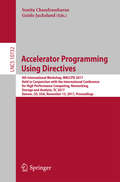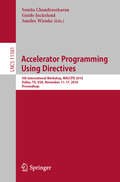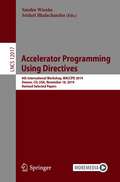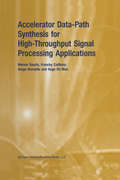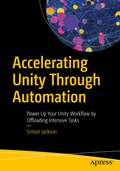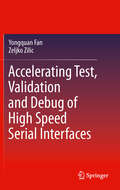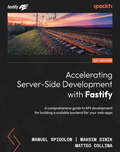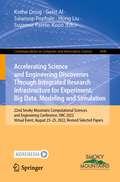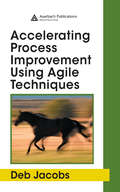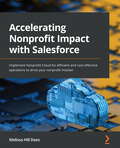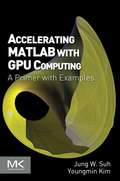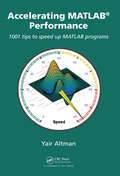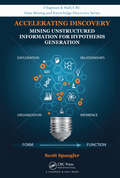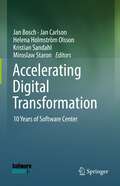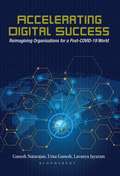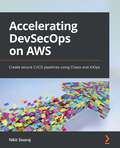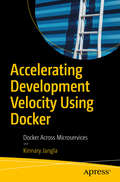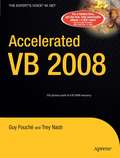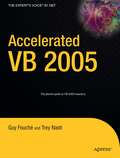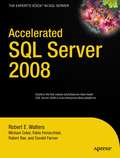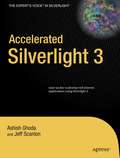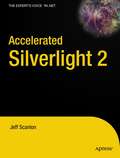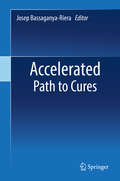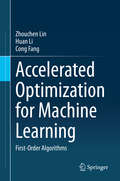- Table View
- List View
Accelerator Programming Using Directives: 4th International Workshop, WACCPD 2017, Held in Conjunction with the International Conference for High Performance Computing, Networking, Storage and Analysis, SC 2017, Denver, CO, USA, November 13, 2017, Proceedings (Lecture Notes in Computer Science #10732)
by Sunita Chandrasekaran Guido JuckelandThis book constitutes the refereed post-conference proceedings of the 4th International Workshop on Accelerator Programming Using Directives, WACCPD 2017, held in Denver, CO, USA, in November 2017.The 9 full papers presented have been carefully reviewed and selected from 14 submissions. The papers share knowledge and experiences to program emerging complex parallel computing systems. They are organized in the following three sections: applications; environments; and program evaluation.
Accelerator Programming Using Directives: 5th International Workshop, WACCPD 2018, Dallas, TX, USA, November 11-17, 2018, Proceedings (Lecture Notes in Computer Science #11381)
by Sunita Chandrasekaran Guido Juckeland Sandra WienkeThis book constitutes the refereed post-conference proceedings of the 5th International Workshop on Accelerator Programming Using Directives, WACCPD 2018, held in Dallas, TX, USA, in November 2018. The 6 full papers presented have been carefully reviewed and selected from 12 submissions. The papers share knowledge and experiences to program emerging complex parallel computing systems. They are organized in the following three sections: applications; using openMP; and program evaluation.
Accelerator Programming Using Directives: 6th International Workshop, WACCPD 2019, Denver, CO, USA, November 18, 2019, Revised Selected Papers (Lecture Notes in Computer Science #12017)
by Sandra Wienke Sridutt BhalachandraThis book constitutes the refereed post-conference proceedings of the 6th International Workshop on Accelerator Programming Using Directives, WACCPD 2019, held in Denver, CO, USA, in November 2019.The 7 full papers presented have been carefully reviewed and selected from 13 submissions. The papers share knowledge and experiences to program emerging complex parallel computing systems. They are organized in the following three sections: porting scientific applications to heterogeneous architectures using directives; directive-based programming for math libraries; and performance portability for heterogeneous architectures.
Accelerator Data-Path Synthesis for High-Throughput Signal Processing Applications
by Werner Geurts Francky Catthoor Serge Vernalde Hugo De ManAccelerator Data-Path Synthesis for High-Throughput Signal Processing Applications is the first book to show how to use high-level synthesis techniques to cope with the stringent timing requirements of complex high-throughput real-time signal and data processing. The book describes the state-of-the-art in architectural synthesis for complex high-throughput real-time processing. Unlike many other, the Synthesis approach used in this book targets an architecture style or an application domain. This approach is thus heavily application-driven and this is illustrated in the book by several realistic demonstration examples used throughout. Accelerator Data-Path Synthesis for High-Throughput Signal Processing Applications focuses on domains where application-specific high-speed solutions are attractive such as significant parts of audio, telecom, instrumentation, speech, robotics, medical and automotive processing, image and video processing, TV, multi-media, radar, sonar, etc. Moreover, it addresses mainly the steps above the traditional scheduling and allocation tasks which focus on scalar operations and data. Accelerator Data-Path Synthesis for High-Throughput Signal Processing Applications is of interest to researchers, senior design engineers and CAD managers both in academia and industry. It provides an excellent overview of what capabilities to expect from future practical design tools and includes an extensive bibliography.
Accelerating Unity Through Automation: Power Up Your Unity Workflow by Offloading Intensive Tasks
by Simon JacksonBuilding games with Unity is hard enough without having to stand up and go and make a coffee each time you want to just build your project or find out days/weeks down the line that some change you made while building your dream has incurred a debt that means your project cannot be built for one of your target platforms without a lot of rework.Through automation, many of these hardships can be detected early and free up time and stress by monitoring your project as it is being created, identify risks and issues as you write the code, and free up your machine while lengthy build processes are running. The change might be hard, but once setup, it will give you peace of mind that everything you create will run, updates will be automatically managed, and your players are less likely to be drafting one-star reviews on your next publication.What You Will Learn• Build the automation of your dreams to accelerate your project• Get detailed examples for generating workflows tailored to your needs• Learn to save time and money by having a backend work for youWho Is This Book ForDevelopers having experience with Unity and interested in learning about (with no foreknowledge in) automation will greatly benefit from this book.
Accelerating Test, Validation and Debug of High Speed Serial Interfaces
by Yongquan Fan Zeljko ZilicHigh-Speed Serial Interface (HSSI) devices have become widespread in communications, from the embedded to high-performance computing systems, and from on-chip to a wide haul. Testing of HSSIs has been a challenging topic because of signal integrity issues, long test time and the need of expensive instruments. Accelerating Test, Validation and Debug of High Speed Serial Interfaces provides innovative test and debug approaches and detailed instructions on how to arrive to practical test of modern high-speed interfaces.Accelerating Test, Validation and Debug of High Speed Serial Interfaces first proposes a new algorithm that enables us to perform receiver test more than 1000 times faster. Then an under-sampling based transmitter test scheme is presented. The scheme can accurately extract the transmitter jitter and finish the whole transmitter test within 100ms, while the test usually takes seconds. The book also presents and external loopback-based testing scheme, where and FPGA-based BER tester and a novel jitter injection technique are proposed. These schemes can be applied to validate, test and debug HSSIs with data rate up to 12.5Gbps at a lower test cost than pure ATE solutions. In addition, the book introduces an efficieng scheme to implement high performance Gaussian noise generators, suitable for evaluating BER performance under noise conditions.
Accelerating Server-Side Development with Fastify: A comprehensive guide to API development for building a scalable backend for your web apps
by Manuel Spigolon Maksim Sinik Matteo CollinaLearn to build faster web applications by implementing maintainable and pluggable APIs with Fastify Purchase of the print or Kindle book includes a free PDF eBookKey FeaturesWritten by Fastify's core contributors to help you adopt the Fastify mindset for API developmentGain an architectural overview of Fastify’s microservices development capabilities and featuresBuild complete apps in Fastify, from application design to productionBook DescriptionThis book is a complete guide to server-side app development in Fastify, written by the core contributors of this highly performant plugin-based web framework. Throughout the book, you’ll discover how it fosters code reuse, thereby improving your time to market. Starting with an introduction to Fastify’s fundamental concepts, this guide will lead you through the development of a real-world project while providing in-depth explanations of advanced topics to prepare you to build highly maintainable and scalable backend applications. The book offers comprehensive guidance on how to design, develop, and deploy RESTful applications, including detailed instructions for building reusable components that can be leveraged across multiple projects. The book presents guidelines for creating efficient, reliable, and easy-to-maintain real-world applications. It also offers practical advice on best practices, design patterns, and how to avoid common pitfalls encountered by developers while building backend applications. By following these guidelines and recommendations, you’ll be able to confidently design, implement, deploy, and maintain an application written in Fastify, and develop plugins and APIs to contribute to the Fastify and open source communities.What you will learnExplore the encapsulation techniques implemented by FastifyUnderstand how to deploy, monitor, and handle errors in a running Fastify instanceOrganize the project structure and implement a microservices architectureExplore Fastify’s core features such as code reuse, runtime speed, and much moreDiscover best practices for implementing Fastify in real-world RESTful appsUnderstand advanced backend development concepts such as performance monitoring and loggingWho this book is forThis book is for mid to expert-level backend web developers who have already used other backend web frameworks and are familiar with HTTP protocol and its peculiarities. Developers looking to migrate to Fastify, evaluate its suitability for their next project, avoid architecture pitfalls, and build highly responsive and maintainable API servers will also find this book useful. The book assumes knowledge of JavaScript programming, Node.js, and backend development.
Accelerating Server-Side Development with Fastify: A comprehensive guide to API development for building a scalable backend for your web apps
by Manuel Spigolon Maksim Sinik Matteo CollinaLearn to build faster web applications by implementing maintainable and pluggable APIs with Fastify Purchase of the print or Kindle book includes a free PDF eBookKey FeaturesWritten by Fastify's core contributors to help you adopt the Fastify mindset for API developmentGain an architectural overview of Fastify’s microservices development capabilities and featuresBuild complete apps in Fastify, from application design to productionBook DescriptionThis book is a complete guide to server-side app development in Fastify, written by the core contributors of this highly performant plugin-based web framework. Throughout the book, you’ll discover how it fosters code reuse, thereby improving your time to market. Starting with an introduction to Fastify’s fundamental concepts, this guide will lead you through the development of a real-world project while providing in-depth explanations of advanced topics to prepare you to build highly maintainable and scalable backend applications. The book offers comprehensive guidance on how to design, develop, and deploy RESTful applications, including detailed instructions for building reusable components that can be leveraged across multiple projects. The book presents guidelines for creating efficient, reliable, and easy-to-maintain real-world applications. It also offers practical advice on best practices, design patterns, and how to avoid common pitfalls encountered by developers while building backend applications. By following these guidelines and recommendations, you’ll be able to confidently design, implement, deploy, and maintain an application written in Fastify, and develop plugins and APIs to contribute to the Fastify and open source communities.What you will learnExplore the encapsulation techniques implemented by FastifyUnderstand how to deploy, monitor, and handle errors in a running Fastify instanceOrganize the project structure and implement a microservices architectureExplore Fastify’s core features such as code reuse, runtime speed, and much moreDiscover best practices for implementing Fastify in real-world RESTful appsUnderstand advanced backend development concepts such as performance monitoring and loggingWho this book is forThis book is for mid to expert-level backend web developers who have already used other backend web frameworks and are familiar with HTTP protocol and its peculiarities. Developers looking to migrate to Fastify, evaluate its suitability for their next project, avoid architecture pitfalls, and build highly responsive and maintainable API servers will also find this book useful. The book assumes knowledge of JavaScript programming, Node.js, and backend development.
Accelerating Science and Engineering Discoveries Through Integrated Research Infrastructure for Experiment, Big Data, Modeling and Simulation: 22nd Smoky Mountains Computational Sciences and Engineering Conference, SMC 2022, Virtual Event, August 23–25, 2022, Revised Selected Papers (Communications in Computer and Information Science #1690)
by Kothe Doug Geist Al Swaroop Pophale Hong Liu Suzanne Parete-KoonThis book constitutes the refereed proceedings of the 22nd Smoky Mountains Computational Sciences and Engineering Conference on Accelerating Science and Engineering Discoveries Through Integrated Research Infrastructure for Experiment, Big Data, Modeling and Simulation, SMC 2022, held virtually, during August 23–25, 2022. The 24 full papers included in this book were carefully reviewed and selected from 74 submissions. They were organized in topical sections as follows: foundational methods enabling science in an integrated ecosystem; science and engineering applications requiring and motivating an integrated ecosystem; systems and software advances enabling an integrated science and engineering ecosystem; deploying advanced technologies for an integrated science and engineering ecosystem; and scientific data challenges.
Accelerating Process Improvement Using Agile Techniques
by Deb JacobsAccelerating Process Improvement Using Agile Techniques explains how agile programming is applied to standard process improvement. By applying agile techniques, IT organizations can speed up process improvement initiatives, minimize the resources these initiatives require, and maximize the benefits of process improvement. The book details st
Accelerating Nonprofit Impact with Salesforce: Implement Nonprofit Cloud for efficient and cost-effective operations to drive your nonprofit mission
by Melissa Hill DeesDrive digital transformation for nonprofits with well-organized volunteer management, donor engagement, fundraising, and grantmaking using the intelligent and powerful capabilities of Salesforce Nonprofit CloudKey FeaturesImplement NPSP modules to scale varied business operations in nonprofitsAdminister and automate business processes and tasks with NPSP for nonprofitsCustomize and extend the standard functionalities of Nonprofit Cloud and NPSP as per client needs, resources, and critical outcomesBook DescriptionSalesforce Nonprofit Cloud enables a 360-degree view of people related to your nonprofit to connect fundraising, program management, and grantmaking. With a single, unified view of every interaction with constituents, nonprofits can create strong relationships with the community and streamline internal processes. The book starts by covering the tools and features that make up Nonprofit Cloud, helping you understand their standard functionalities and how Nonprofit Success Pack's (NPSP) data architecture is critical to implementation. You'll learn how the Nonprofit Cloud Program Management Module can connect your programs, automate case management, and track client progress. Next, you'll explore the tools for creating a change management process to increase user adoption. Moving ahead, you'll understand how to configure necessary permissions for NPSP administration and explore how declarative tools help better align the goals of a nonprofit organization. Toward the concluding chapters, you'll cover customizations, deployment, custom reports, and dashboards for fundraising analytics, as well as best practices for data management to maintain its integrity. By the end of this Salesforce book, you'll be able to build and configure the Nonprofit Cloud for a variety of use cases to achieve maximum social impact with the least amount of technical debt.What you will learnImplement various components and modules in Nonprofit CloudImplement tools for grantmaking, program management, and case managementExtend the standard functionalities of Nonprofit Cloud and NPSPIdentify and use success metrics to prioritize goals and outcomes for implementationExplore the tools that Nonprofit Cloud offers for testing and deploymentBuild custom reports and dashboards for NPSP and use Tableau dashboard starters for fundraising analyticsUnderstand best practices for data management to maintain data accuracy and data integrityWho this book is forThis book is for technical consultants, functional consultants, and Salesforce architects who are working with nonprofit organizations and want to implement different functionalities within Nonprofit Cloud and NPSP optimally for business processes and tasks in their organizations. Salesforce administrator skills and overall proficiency with Salesforce are required to get the most out of this book.
Accelerating MATLAB with GPU Computing: A Primer with Examples
by Youngmin Kim Jung W. SuhBeyond simulation and algorithm development, many developers increasingly use MATLAB even for product deployment in computationally heavy fields. This often demands that MATLAB codes run faster by leveraging the distributed parallelism of Graphics Processing Units (GPUs). While MATLAB successfully provides high-level functions as a simulation tool for rapid prototyping, the underlying details and knowledge needed for utilizing GPUs make MATLAB users hesitate to step into it. Accelerating MATLAB with GPUs offers a primer on bridging this gap. Starting with the basics, setting up MATLAB for CUDA (in Windows, Linux and Mac OS X) and profiling, it then guides users through advanced topics such as CUDA libraries. The authors share their experience developing algorithms using MATLAB, C++ and GPUs for huge datasets, modifying MATLAB codes to better utilize the computational power of GPUs, and integrating them into commercial software products. Throughout the book, they demonstrate many example codes that can be used as templates of C-MEX and CUDA codes for readers’ projects. Download example codes from the publisher's website: http://booksite.elsevier.com/9780124080805/Shows how to accelerate MATLAB codes through the GPU for parallel processing, with minimal hardware knowledgeExplains the related background on hardware, architecture and programming for ease of useProvides simple worked examples of MATLAB and CUDA C codes as well as templates that can be reused in real-world projects
Accelerating MATLAB Performance: 1001 tips to speed up MATLAB programs
by Yair M. AltmanThe MATLAB programming environment is often perceived as a platform suitable for prototyping and modeling but not for "serious" applications. One of the main complaints is that MATLAB is just too slow. Accelerating MATLAB Performance aims to correct this perception by describing multiple ways to greatly improve MATLAB program speed. Packed with tho
Accelerating Discovery: Mining Unstructured Information for Hypothesis Generation
by Scott SpanglerUnstructured Mining Approaches to Solve Complex Scientific ProblemsAs the volume of scientific data and literature increases exponentially, scientists need more powerful tools and methods to process and synthesize information and to formulate new hypotheses that are most likely to be both true and important. Accelerating Discovery: Mining Unstructu
Accelerating Digital Transformation: 10 Years of Software Center
This book celebrates the 10-year anniversary of Software Center (a collaboration between 18 European companies and five Swedish universities) by presenting some of the most impactful and relevant journal or conference papers that researchers in the center have published over the last decade. The book is organized around the five themes around which research in Software Center is organized, i.e. Continuous Delivery, Continuous Architecture, Metrics, Customer Data and Ecosystems Driven Development, and AI Engineering. The focus of the Continuous Delivery theme is to help companies to continuously build high quality products with the right degree of automation. The Continuous Architecture theme addresses challenges that arise when balancing the need for architectural quality and more agile ways of working with shorter development cycles. The Metrics theme studies and provides insight to understand, monitor and improve software processes, products and organizations. The fourth theme, Customer Data and Ecosystem Driven Development, helps companies make sense of the vast amounts of data that are continuously collected from products in the field. Eventually, the theme of AI Engineering addresses the challenge that many companies struggle with in terms of deploying machine- and deep-learning models in industrial contexts with production quality. Each theme has its own part in the book and each part has an introduction chapter and then a carefully selected reprint of the most important papers from that theme. This book mainly aims at researchers and advanced professionals in the areas of software engineering who would like to get an overview about the achievement made in various topics relevant for industrial large-scale software development and management – and to see how research benefits from a close cooperation between industry and academia.
Accelerating Digital Success: Reimagining Organisations for a Post-COVID-19 World
by Ganesh Natarajan Uma Ganesh Lavanya JayaramThere is a major business transformation going on across multiple industries worldwide: the need to automate, digitize their business process and rush to give a better experience to both their customers and employees. Organizations are trying to gain a competitive advantage by launching new digital journeys quickly, rapidly and in an agile manner – all of which demands a cultural shift. Through this book, CEOs, CFO, CIOs and Chief Digital Officers of organizations who have embarked on the journey of digital transformation but have not been able to fully realise the benefits will gain insights on aligning their existing investment with newer initiatives, as well as develop a proper roadmap for their digital future. Through the plans and deeds of real-life examples of those who have attempted and achieved digital acceleration on their own or in client organizations, readers will learn the proper methods of creating multiple digital accelerators, how to culturally align to new agile ways of delivering rapid solutions, and become aware of new mantras of the API economy which can out digital success on steroids!.
Accelerating DevSecOps on AWS: Create secure CI/CD pipelines using Chaos and AIOps
by Nikit SwarajBuild high-performance CI/CD pipelines that are powered by AWS and the most cutting-edge tools and techniquesKey FeaturesMaster the full AWS developer toolchain for building high-performance, resilient, and powerful CI/CD pipelinesGet to grips with Chaos engineering, DevSecOps, and AIOps as applied to CI/CDEmploy the latest tools and techniques to build a CI/CD pipeline for application and infrastructureBook DescriptionContinuous integration and continuous delivery (CI/CD) has never been simple, but these days the landscape is more bewildering than ever; its terrain riddled with blind alleys and pitfalls that seem almost designed to trap the less-experienced developer. If you're determined enough to keep your balance on the cutting edge, this book will help you navigate the landscape with ease. This book will guide you through the most modern ways of building CI/CD pipelines with AWS, taking you step-by-step from the basics right through to the most advanced topics in this domain.The book starts by covering the basics of CI/CD with AWS. Once you're well-versed with tools such as AWS Codestar, Proton, CodeGuru, App Mesh, SecurityHub, and CloudFormation, you'll focus on chaos engineering, the latest trend in testing the fault tolerance of your system. Next, you'll explore the advanced concepts of AIOps and DevSecOps, two highly sought-after skill sets for securing and optimizing your CI/CD systems. All along, you'll cover the full range of AWS CI/CD features, gaining real-world expertise.By the end of this AWS book, you'll have the confidence you need to create resilient, secure, and performant CI/CD pipelines using the best techniques and technologies that AWS has to offer.What you will learnUse AWS Codestar to design and implement a full branching strategyEnforce Policy as Code using CloudFormation Guard and HashiCorp SentinelMaster app and infrastructure deployment at scale using AWS Proton and review app code using CodeGuruDeploy and manage production-grade clusters using AWS EKS, App Mesh, and X-RayHarness AWS Fault Injection Simulator to test the resiliency of your appWield the full arsenal of AWS Security Hub and Systems Manager for infrastructure security automationEnhance CI/CD pipelines with the AI-powered DevOps Guru serviceWho this book is forThis book is for DevOps engineers, engineering managers, cloud developers, and cloud architects. Basic experience with the software development life cycle, DevOps, and AWS is all you need to get started.
Accelerating Development Velocity Using Docker: Docker Across Microservices
by Kinnary JanglaDiscover how a software engineer can leverage Docker in order to expedite development velocity. This book focuses on the fundamental concepts this program is built upon and explores how it can help you get your services up and running inside Docker containers. You'll also review tips on how to debug microservices applications that run inside Docker containers.Tech companies are now developing complex softwares that are comprised of multiple services running on different platforms, and Docker has become an essential part of coordinating the communication between these services and platforms. This book addresses problems caused by drifting microservices, debugging across services, inconsistent environments across machines, and coordinating development of machine learning systems between a team of developers, etc. Accelerating Development Velocity Using Docker puts you on the path to transforming your complex systems into more efficient ones.What You'll LearnSetup Docker and employ quick solutions to road blocksReview challenges associated with debugging microservices that sit behind a complex applicationLeverage Docker features to seamlessly get multiple microservices up and runningDebug inside a Docker containerReview advanced use cases of Docker that can help consistency of development environments· Who This Book Is ForIdeal for new to mid-level infrastructure engineers who want to learn how to make their development environments efficient across their and cross teams, or for students who aspire to learn basics of how to debug distributed systems and how to develop efficient applications.
Accelerated VB 2008
by Trey NashAccelerated VB 9.0 is the fastest path to VB mastery. All VB programmers need to know and understand how VB really works but very few books address this. No other book covers the topic in the depth that this book does. It teaches both core VB language concepts and how to use them in high-performance code. All programmers moving to VB from any language or moving up to VB 9.0 from VB 2005 will find this book well worth buying, reading, and using as a reference.
Accelerated VB 2005
by Trey NashThis book provides the fastest path to VB expertise for programmers transitioning to VB from another object-oriented language. It quickly brings experienced Java, C#, and C++ programmers to a high level of proficiency in VB. It also provides in-depth advice on the wise use of VB to exploit the power of the .NET Common Language Runtime (CLR). Coverage carefully describes how VB works, discusses the most important issues for professional VB coding, and demonstrates with precise examples how to design and code effective VB programs. Its succinctness and clarity make it appropriate for anyone familiar with any object-oriented language.
Accelerated SQL Server 2008
by Michael Coles Fabio Claudio Ferracchiati Robert Walters Chris Farmer Jonathan RaeAccelerated SQL Server 2008 is a fast introduction to SQL Server 2008 for experienced database professionals. The book will appeal to readers who are smart, who learn fast, and who do not want to wade through a large amount of introductory material. The goal is to impart the essentials of using SQL Server 2008 as quickly as possible.
Accelerated Silverlight 3
by Jeff Scanlon Ashish GhodaAccelerated Silverlight 3 teaches you how to get up to speed with the latest version of Silverlight quickly and efficiently. The book assumes you're already comfortable with the basics of .NET coding and with WPF and builds on your existing knowledge to make your journey to Silverlight 3 proficiency as quick and painless as possible. Where coding techniques are similar to other, more established, areas of .NET, the text says so. Likewise, where there's a syntax or conceptual "gotcha" that you're existing coding habits will walk you into, the text points that out, too. This book provides you with fast-track coverage of all the most important elements of the Silverlight 3 technology ranging from XAML to standard controls, from dealing with media to networking, from testing to deployment. It concludes with a pair of fully worked sample applications for you to follow through, because nothing reinforces your understanding of how concepts fit together as much as looking at finished code. It is assumed that readers are already be comfortable with the workings of the .NET framework. Knowledge of Expression Blend is useful, but not mandatory: you'll learn the Blend techniques that you need to know as you go through the book. By the end, you will have followed a sound, concise, path to mastery of Silverlight 3.
Accelerated Silverlight 2
by Jeff ScanlonAccelerated Silverlight 2 will get you up to speed with version 2 of Silverlight quickly and efficiently. Author Jeff Scanlon assumes you're already comfortable with the basics of .NET coding and with Windows Presentation Foundation (WPF), and helps you build on your existing knowledge to make your journey to Silverlight 2 proficiency as quick and painless as possible. Where coding techniques are similar to other, more established areas of .NET, he'll say so. Likewise, where there's a syntax or conceptual “gotcha” that you're existing coding habits will walk you into, he'll point that out, too. You'll find fast–track coverage of all the most important elements of the Silverlight 2 technology ranging from XAML to standard controls, from dealing with media to networking, from testing to deployment. Two fully-worked sample applications conclude your path to Silverlight 2 mastery because nothing reinforces your understanding of how concepts fit together as much as looking at finished code. The book is based on the assumption that readers will already be very comfortable with the workings of the .NET Framework. Knowledge of Expression Blend is useful, but the author doesn't assume that you're a master of it. You'll learn the Blend techniques that you need to know as you go along. By the end of the book, the author will have provided you with a sound, concise, path to mastery of Silverlight 2.
Accelerated Path to Cures
by Josep Bassaganya-RieraAccelerated Path to Cures provides a transformative perspective on the power of combining advanced computational technologies, modeling, bioinformatics and machine learning approaches with nonclinical and clinical experimentation to accelerate drug development. This book discusses the application of advanced modeling technologies, from target identification and validation to nonclinical studies in animals to Phase 1-3 human clinical trials and post-approval monitoring, as alternative models of drug development. As a case of successful integration of computational modeling and drug development, we discuss the development of oral small molecule therapeutics for inflammatory bowel disease, from the application of docking studies to screening new chemical entities to the development of next-generation in silico human clinical trials from large-scale clinical data. Additionally, this book illustrates how modeling techniques, machine learning, and informatics can be utilized effectively at each stage of drug development to advance the progress towards predictive, preventive, personalized, precision medicine, and thus provide a successful framework for Path to Cures.
Accelerated Optimization for Machine Learning: First-Order Algorithms
by Zhouchen Lin Huan Li Cong FangThis book on optimization includes forewords by Michael I. Jordan, Zongben Xu and Zhi-Quan Luo. Machine learning relies heavily on optimization to solve problems with its learning models, and first-order optimization algorithms are the mainstream approaches. The acceleration of first-order optimization algorithms is crucial for the efficiency of machine learning. Written by leading experts in the field, this book provides a comprehensive introduction to, and state-of-the-art review of accelerated first-order optimization algorithms for machine learning. It discusses a variety of methods, including deterministic and stochastic algorithms, where the algorithms can be synchronous or asynchronous, for unconstrained and constrained problems, which can be convex or non-convex. Offering a rich blend of ideas, theories and proofs, the book is up-to-date and self-contained. It is an excellent reference resource for users who are seeking faster optimization algorithms, as well as for graduate students and researchers wanting to grasp the frontiers of optimization in machine learning in a short time.
